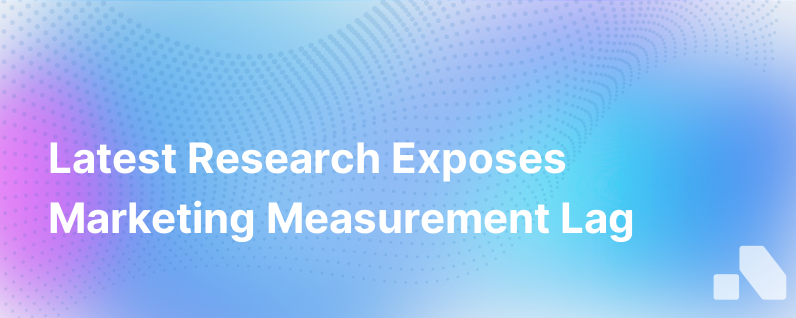Latest Research How Marketing Measurements Are Lagging
Published on August 4, 2023 by Sawyer Middeleer
In the ever-evolving digital landscape, marketing has gone from an often guess-and-check art form to a data-driven science. While advancements in technology have supercharged our ability to capture and analyze consumer behavior, recent research suggests that marketing measurement methodologies are struggling to keep pace. This lag is resulting both from rapidly changing consumer behavior and evolving technology platforms. The implications are profound, affecting everything from marketing budget allocations to predicting consumer trends and behavior.
Let's dive deep and understand where marketing measurements are falling short and the need for more sophisticated, real-time analytical tools and methodologies, such as the AI-driven insights platform offered by Aomni.
The Current State of Marketing Measurements
Marketing measurement, the practice of evaluating the impact of marketing initiatives against key performance indicators (KPIs), has traditionally relied heavily on retrospective analyses of large data sets. Today’s consumer journey is more fragmented than ever before, spreading across multiple channels and devices. The methodologies used for attribution - the process of identifying a set of user actions that contribute to the desired outcome and then assigning a value to each of these events - have not evolved at the same speed as consumer behavior.
Traditional measurement techniques, which often include last-click attribution or even first-click attribution, fail to account for the complexity of multi-touch interactions and the non-linear path to purchase. Last-click attribution, in particular, overlooks the various touchpoints that may have played pivotal roles in the consumer's decision-making process. Meanwhile, marketing mix modeling (MMM), which measures the impact of various marketing tactics on sales and then forecasts the impact of future sets of tactics, often falls short due to data latency and the static nature of its modeling.
The Lag in Measurement
According to recent studies, including those conducted by leading marketing research firms, marketing measurements are lagging for the following reasons:
- Data Fragmentation: The increasing number of marketing channels has led to fragmented data sources, creating challenges in collecting and unifying data for accurate measurement.
- Consumer Privacy Concerns: With regulations like GDPR and CCPA, and moves by major industry players to eliminate third-party cookies, marketers are facing difficulties in tracking consumers across the web, thus hindering the collection of essential marketing data.
- Real-time Analytics: The majority of traditional marketing analytics tools are ineffective in processing and analyzing data in real time. In a world where consumer sentiment and behaviors can shift instantaneously, the ability to respond quickly is critical.
- Cross-Device Tracking: As consumers seamlessly move between devices, comprehensive cross-device tracking and measurement have become more complex but also more essential.
- Predictive Analytics Shortfalls: There is an increasing need for predictive analytics to forecast future trends. Traditional tools are often lagging in accuracy when it comes to predicting market shifts and consumer behavior.
The Impact of Lagging Marketing Measurements
The lag in marketing measurement has significant impacts on businesses:
- Resource Misallocation: Misunderstanding which touchpoints are driving conversions can lead to misallocation of marketing spend. Inaccuracies can lead to over-investing in inefficient channels and neglecting areas with potential high ROI.
- Inability to Capitalize on Trends: Failure to rapidly adapt to market trends can result in missed opportunities. Real-time data analysis is critical in today's fast-paced market to remain competitive.
- Customer Experience and Personalization: Without a precise understanding of customer journeys, personalization efforts can miss the mark, leading to displeased customers and potentially brand attrition.
- Poor Decision Making: Strategic decisions based on faulty measurements can have far-reaching consequences, including impacting product development, market entry strategies, and customer relationship management.
Toward Better Marketing Measurements
To combat these challenges, brands need to invest in modern measurement tools that offer real-time analysis, predictive capabilities, and AI-driven insights. Here are some solutions:
- Utilizing AI and Machine Learning: AI can analyze vast amounts of data at incredible speeds, offering real-time insights and predictive analytics. Platforms like Aomni harness these capabilities to provide businesses with real-time account research and competitive insights at the click of a button.
- Embracing Unified Data Platforms: Integrating data across systems and platforms allows for a cohesive view of the customer journey, enabling more precise measurements and optimizations.
- Implementing Multi-Touch Attribution Models: Moving beyond last-click attribution to models that recognize the role each touchpoint plays in the conversion process provides a truer picture of what's working.
- Improving Cross-Device Attribution: Technological advancements that provide better tracking of user behavior across devices are essential to understand the modern consumer’s path to purchase.
- Prioritizing Consumer Privacy: Adopting privacy-first strategies while still collecting essential data for measurement requires a balance that respects user preferences and complies with regulations.
Conclusion
The current lag in marketing measurements is a hurdle that organizations must overcome to remain competitive and resonate with their audiences. Staying ahead requires a dynamic approach to marketing analytics, embracing innovation, and leveraging cutting-edge tools, such as those powered by AI and machine learning.
By reassessing their measurement strategies, companies can not only improve the efficiency of their marketing spend but also enhance customer experiences, forecast trends with greater accuracy, and foster sustainable growth. As we continue to navigate the complexities of the digital landscape, the evolution from lagging measurements to insights-driven marketing will be pivotal in shaping the future of successful marketing strategies.